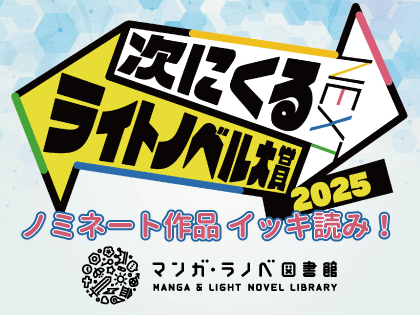



The Manga & Light Novel Library at Kadokawa Culture Museum houses a vast collection of about 32,000 Japanese light novels and approximately 10,000 titles of manga and children's books, all published by Kadokawa. It offers an immersive literary journey through time, from contemporary buzz-worthy releases to the influential classics that have shaped the genre. Visitors are invited to explore these literary treasures in a serene setting, bathed in natural light streaming through large front windows or on the comfortable outdoor deck. Please note, however, that books are not available for loan.
*This library does not loan out books.

-
「怖っ」ミニ特集
〜 2025/09/01[Mon] -
ひろがるラノベ(1990年代)
2024/12/04[Wed] 〜 2025/02/23[Sun] -
「次にくるライトノベル大賞2024」結果発表!上位作品所蔵リスト
2025/02/24[Mon] 〜 2025/05/31[Sat] -
ライトノベルのはじまり(1980年代まで)
2024/05/08[Wed] 〜 2024/12/03[Tue] -
「次にくるライトノベル大賞2023」結果発表!上位作品所蔵リスト
2023/11/16[Thu] 〜 2024/05/06[Mon] -
「2023年 夏のアニメ化作品」特集!
2023/07/05[Wed] 〜 2023/10/02[Mon] -
悪役令嬢 淑女録 悪役令嬢がたくさんいるので、推させていただきます!
2023/05/31[Wed] 〜 2023/09/04[Mon] -
「2023年 春のアニメ化作品」特集!
2023/04/05[Wed] 〜 2023/07/03[Mon] -
文豪ストレイドッグス特設棚
2023/03/30[Thu] 〜 2023/05/07[Sun] -
2023年冬のアニメ化作品!
2023/01/13[Fri] 〜 2023/04/03[Mon] -
らき☆たま展/埼玉アニメ聖地展
2022/12/07[Wed] 〜 2023/02/26[Sun] -
なつやすみ課題図書特集
2022/07/20[Wed] 〜 2022/09/05[Mon] -
TRPG特集展示『TRPG三昧』
2022/07/20[Wed] 〜 2022/11/14[Mon] -
2022年夏のアニメ化作品!
2022/07/12[Tue] 〜 2022/10/03[Mon] -
異世界ほんだな
2022/05/18[Wed] 〜 2022/07/18[Mon] -
リラックマ&すみっコぐらし マンガ・ラノベ図書館のかたすみでごゆるりと特集
2022/04/06[Wed] 〜 2022/05/16[Mon] -
電撃小説大賞 特集展示『電撃のみちのり』
2022/04/08[Fri] 〜 2022/05/16[Mon] -
『鹿の王 ユナと約束の旅』公開記念ハイ・ファンタジー特集 『幻想世界への旅路』
2022/02/02[Wed] 〜 2022/04/18[Mon] -
安彦良和の戦い
2022/01/24[Mon] 〜 2022/04/04[Mon] -
埼玉150周年記念特集
2021/11/03[Wed] 〜 2022/01/31[Mon]







First floor
The first floor of the Manga & Light Novel Library houses around 10,000 books, including a diverse selection of manga and children's literature published by Kadokawa. The children's collection ranges from picture books, educational manga, Tsubasa Bunko publications, to digital picture books, and more. Additionally, this floor features various special sections, each showcasing current recommendations across genres of manga and light novels.

Mezzanine floor
The mezzanine floor of the library boasts a collection of around 32,000 light novels from 20 publishers. These books are organized in Japanese syllabary order by the authors' names. (Note: This count is accurate as of June 2025.)

"Encountering New Stories" bookshelves for new publications
A steady influx of new publications, including monthly light novels, Kadokawa comics, and children's books, is continually added to our collection here.

"Books Are Friends" bookshelves for children's books
Occupying a corner on the first floor, we've curated a collection perfect for a child's first reading experience, including picture books, children’s literature (Tsubasa Bunko), and educational manga. Moreover, visitors can explore "content of the new era," such as digital picture books accessible via a smart device (iPad), and creative apps designed to stimulate children’s imagination.

GENYOSHI GARDEN
This is a garden that recreates the "Aogaki Sanbo (Green Persimmon Mountain Cottage)"that Genyoshi Kadokawa, the founder of Kadokawa Shoten, once had at his former residence in Ogikubo, Suginami-ku, Tokyo. Designed by Seijun Nishihata of the "Sora Botanical Garden", the space features aki-no-nanakusa (seven autumnal flowers) and weeping cherry trees centering around a magnolia tree, a species beloved by Genyoshi. On pleasant weather days, visitors can enjoy reading books on the wooden deck here.


The information is as of the time of the publishing of the video.
Declaration of Light Novels
In Commemoration of the Opening of the Manga & Light Novel Library
Modern literature, exemplified by author Natsume Soseki, evolved into diverse forms of highbrow literature and mass-market novels during the Showa era. These works, over time, found their place as classics within contemporary Japanese textbooks.
However, the young adult demographic, in search of literature capturing the essence of youth, yearned for stories they could choose for themselves.
Light novels (a Japanese term for young adult novels) are often the first choice for adolescents not content with the literature already available to them, carved out a unique, rich literary space situated between children's literature and adult fiction.
The language used in light novels offers a vibrant representation of the contemporary era. A notable characteristic is the tangible sense that the author breathes the same air and shares the same era as the reader.
The roots of light novels can be traced back to "Record of Lodoss War" which based on "RPG replays and influenced by the UK's "Knights of the Round Table" and "The Lord of the Rings". The novel "Record of Lodoss War" was created by Ryo Mizuno based on a video game in which it is possible to spin an increasingly rich story as more players join the game.
This mere A6 pocket-sized publication occupied an entire corner of Kadokawa Bunko, became best seller that enthralled young boys and girls. According to a survey by the Mainichi Shimbun, it held the top spot in lending rates in middle and high school libraries for an impressive ten-year run.
Changing Time, Changing Publishing.
Throughout the extensive course of human history, Japanese content, often categorized as subculture, has infused a refreshing dynamism into the high-culture arts traditionally nurtured by the West. From manga and anime to video games, young people worldwide have shown a receptive affinity towards content originating from Japan. Yet, light novels – an additional, uniquely Japanese form of creative expression – demonstrate an even more formidable communicative prowess.
Although this library does accommodate comics, it can rightfully be considered the world's most extensive library specifically dedicated to light novels.
Tsuguhiko Kadokawa


